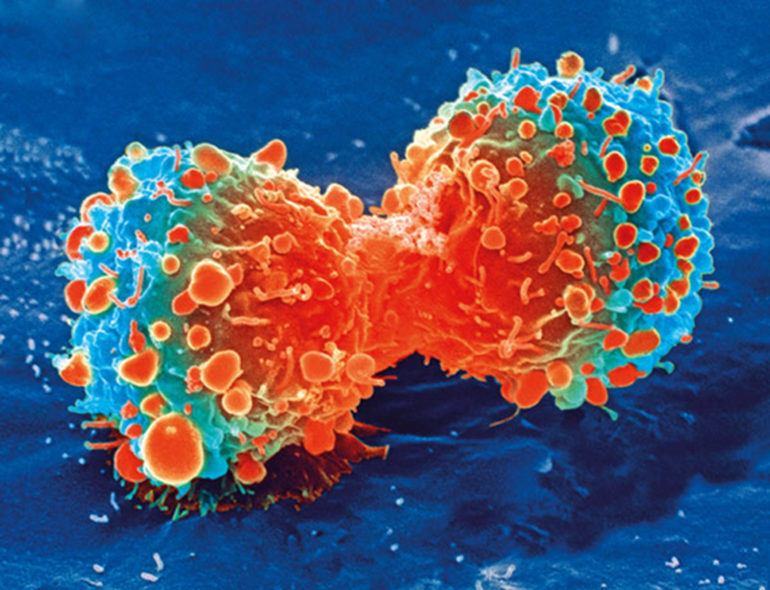Preclinical research from VCU Massey Cancer Center published recently in the Proceedings of the National Academy of Sciences shows that the combination of two existing drugs can exploit the metabolic ‘hunger’ of a particularly aggressive type of neuroblastoma to kill cancer cells without inflicting too much collateral damage to healthy tissue.
Neuroblastoma—a type of cancer that strikes the nervous system of very young children—is one of the deadliest pediatric cancers. And children whose neuroblastoma overexpresses the gene MYCN tend to have the worst prognosis.
While medical advancements have led to high cure rates among pediatric blood cancers, neuroblastoma has proven much more challenging to treat, largely because the gene that makes this cancer so deadly is a tough one to target.
“MYCN is a transcription factor, and it’s very difficult to drug transcription factors,” said study senior author Anthony Faber, Ph.D., co-leader of the Developmental Therapeutics research program and Natalie N. and John R. Congdon, Sr. Endowed Chair of Cancer Research at VCU Massey Cancer Center and associate professor in the Philips Institute for Oral Health Research at the VCU School of Dentistry. “So, the next best thing is to target what MYCN does in the cell. One thing it does is to crank up metabolic activity—what it’s doing to keep the cell alive—and we can work that against itself.”
These neuroblastoma cells exist on the brink of metabolic overdrive, gobbling up energy stores as quickly as the cell can replenish them, so Faber’s team sought ways to push these cells over the edge, without harming normal cells in the process.
The researchers screened 20 metabolic drug combinations in cancer cells originating from nearly 1,000 different patients and found that neuroblastoma with high MYCN expression was particularly sensitive to a cocktail containing two drugs: phenformin and AZD3965.
Phenformin, which blocks complex I on the surface of mitochondria—the sub-cellular compartment where energy production occurs—was developed in 1957 to treat diabetes. Although the Food and Drug Administration took phenformin off the market in the 1970s following a string of deaths, it’s still in use elsewhere in the world and is starting to make a comeback in the U.S. as a cancer drug. Right now, phenformin is being tested in a phase I clinical trial for melanoma.
AZD3965, a much newer type of drug that blocks MCT1 rectors on the surface of cells, is also under phase I clinical investigation, in this case as a treatment for many different types of cancer. MCT1 receptors ferry lactate—another source of energy—out of the cell. But when MCT1 is blocked and lactate accumulates, the cell stops using it to make energy.
Since the receptors targeted by phenformin and AZD3965 participate in energy production through two distinct pathways, blocking them both at once should dramatically disrupt the cellular power supply, leading to stress and ultimately cell death.
Faber’s team tested this idea by using mice seeded with MYCN-amplified neuroblastoma patient cells and found that animals treated with both drugs saw greater tumor shrinkage than animals given either drug alone, and the cocktail was well tolerated.
“The data we got with AZD3965 in combination with phenformin might get people to reconsider phenformin,” said study lead author Krista Dalton, M.Eng., a Ph.D. student in the VCU Philips Institute for Oral Health Research. “In combination, where we can use lower doses, phenformin might have better tolerability than it previously did on its own.”
Abundance of iron drives cell death and could inform novel treatments for neuroblastoma
More information:
Krista M. Dalton et al, Catastrophic ATP loss underlies a metabolic combination therapy tailored for MYCN-amplified neuroblastoma, Proceedings of the National Academy of Sciences (2021). DOI: 10.1073/pnas.2009620118
Provided by
Virginia Commonwealth University
Citation:
Bespoke neuroblastoma therapy weaponizes cell metabolism (2021, March 30)
retrieved 31 March 2021
from https://medicalxpress.com/news/2021-03-bespoke-neuroblastoma-therapy-weaponizes-cell.html
This document is subject to copyright. Apart from any fair dealing for the purpose of private study or research, no
part may be reproduced without the written permission. The content is provided for information purposes only.



